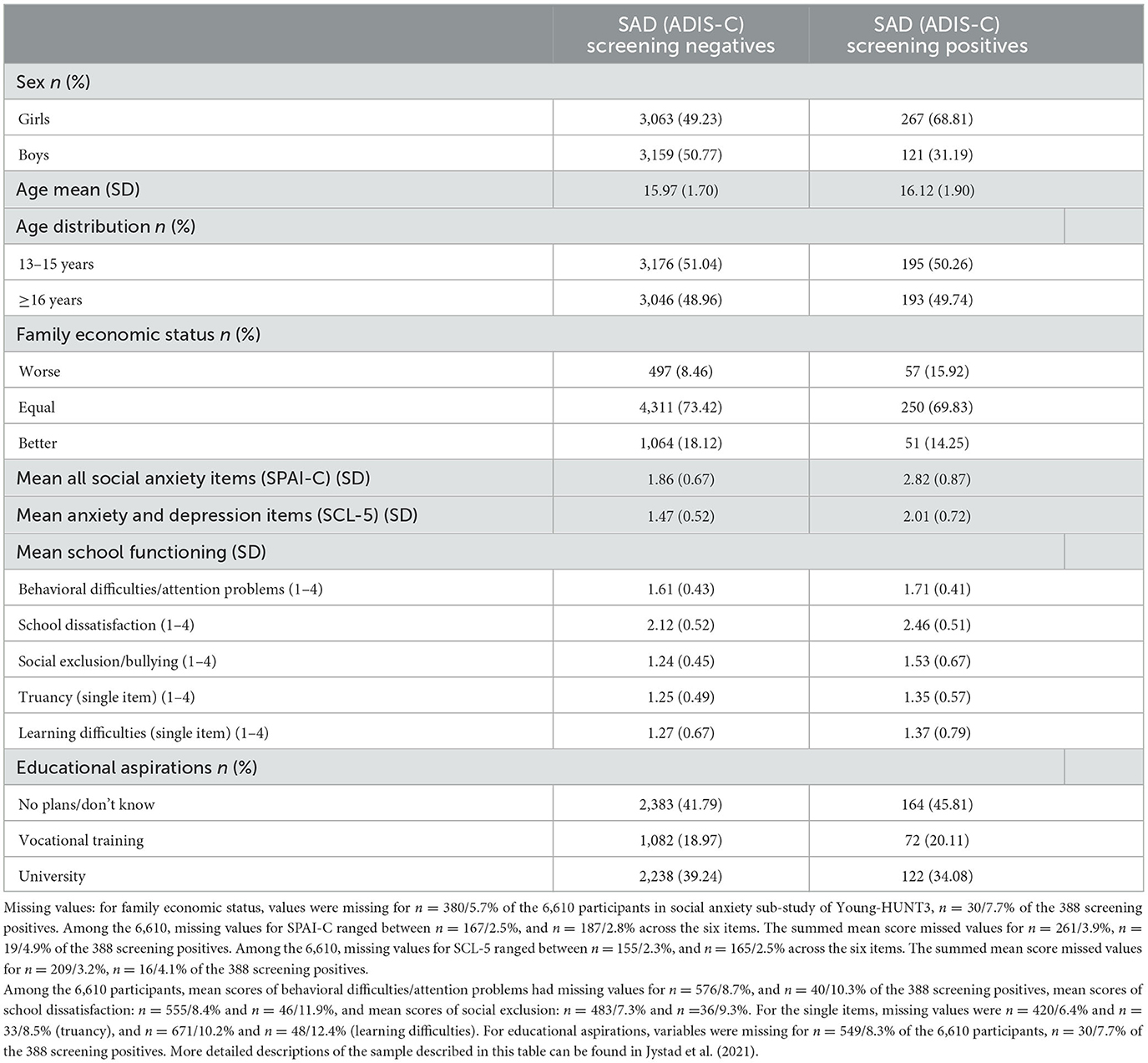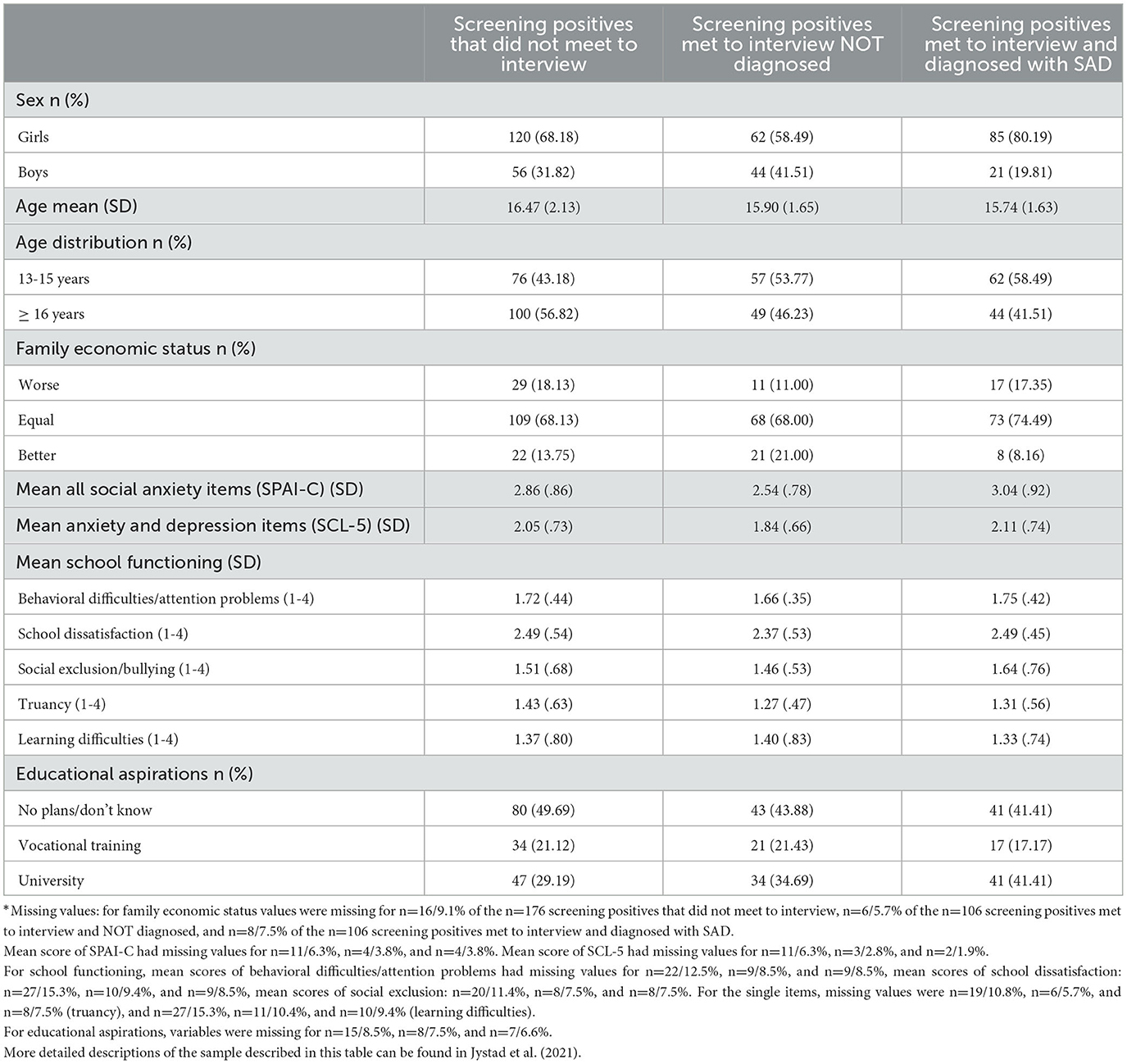
95% of researchers rate our articles as excellent or good
Learn more about the work of our research integrity team to safeguard the quality of each article we publish.
Find out more
CORRECTION article
Front. Psychol. , 30 June 2023
Sec. Educational Psychology
Volume 14 - 2023 | https://doi.org/10.3389/fpsyg.2023.1228198
This article is a correction to:
School Functioning and Educational Aspirations in Adolescents With Social Anxiety—The Young-HUNT3 Study, Norway
A corrigendum on
School functioning and educational aspirations in adolescents with social anxiety—The Young-HUNT3 study, Norway
by Jystad, I., Haugan, T., Bjerkeset, O., Sund, E. R., and Vaag, J. (2021). Front. Psychol. 12:727529. doi: 10.3389/fpsyg.2021.727529
In the published article, there was an error in Table 1 as published. In the rows “Mean all social anxiety items (SPAI-C), (sd),” “Mean anxiety and depression items (SCL-5) (sd),” “Behavioral difficulties/attention problems (1–4),” “School dissatisfaction (1–4),” “Social exclusion/bullying (1–4),” “Truancy (single item) (1–4),” and “Learning difficulties (single item) (1–4),” the mean values were erroneously reported with standard errors (SE) instead of standard deviations (SD). The corrected Table 1 and its caption appear below.

Table 1. Descriptive characteristics of adolescents in YoungHUNT3 categorized/identified as ADIS-C screening negative (n = 6,222) and ADIS-C screening positive (n = 388).
In the published article, there were also errors in the text. In the descriptions of the statistical methods, a sentence was erroneously placed in paragraph 3 in the description of Poisson regression analyses. It should be placed in paragraph 4 in the description of multiple logistic regression analyses.
A correction has been made to Methods, Statistics, Paragraphs 3 and 4. The corrected paragraphs are shown below.
Second, in multiple Poisson regression analysis, requesting robust standard errors, associations were estimated between the SP group (n = 388) and five factors of school functioning: sum score of behavioral difficulties/attention problems, sum score of school dissatisfaction, and sum score of social exclusion using SN group as a reference. The same procedure was performed for the two single items of school functioning (learning difficulties and truancy). Further, the variables of school functioning were investigated using mean SPAI-C scores (continuous variable), (“SPAI-C score”), as predictor variables in the robust multiple Poisson regression model, involving the total sample who answered the self-report questionnaire (n = 8,199). The same was performed with a mean score of SCL-5 (“SCL-5 score”) as the predictor (n = 8,199). Results are reported as rate ratios (RR) along with 95% confidence intervals (95% CI).
Finally, multiple logistic regression analysis was performed to estimate the odds ratio (OR) for the association between the ADIS-C SP group and aspirations for further education, using the ADIS-C SN group as the reference group (n = 6,610). The same procedure was performed using mean scores of (1) SPAI-C and (2) SCL-5 as predictors, involving the total sample (n = 8,199). The analyses for SPAI-C and SCL-5 as predictors were then repeated and performed separately for students in lower secondary school (13–15 years of age) and upper secondary school (≥16 years of age). Results are reported as odds ratios (OR) with 95% confidence intervals (95% CI). All analyses were adjusted for sex, age (measured on a continuous scale), and perception of family economic status.
Lastly, in the published article, there was a minor error when describing descriptive characteristics and aspirations of going to university. We want to include “partly” to the sentence describing the tendency seen in SP subgroups. Even though the general tendency is also seen in the subgroups, we see the need for nuancing.
A correction has been made to Results, Descriptive Characteristics, Paragraph 2. The corrected paragraph is shown below.
A lower proportion of the SP group reported aspirations of going to university compared to the SN group (SP: 34.1%, SN: 39.2%), and a higher proportion of the SP group answered no plans/don't know (SP: 45.8%, SN: 41.8%). This was also partly observed for the three SP subgroups (see Supplementary Material). Regarding age differences, a higher proportion of adolescents under the age of 16 answered no plans/don't know (48.6%) compared to adolescents over the age of 16 (35.4%). For remaining descriptive characteristics, see Table 1.
In the published article, there was also an error in Supplementary Table 1. In the rows “Mean all social anxiety items (SPAI-C) (sd),” “Mean anxiety and depression items (SCL-5) (sd),” “Behavioral difficulties/attention problems (1-4),” “School dissatisfaction (1-4),” “Social exclusion/bullying (1-4),” “Truancy (single item) (1-4)” and “Learning difficulties (single item) (1-4),” the mean values were erroneously reported with standard errors (SE) instead of standard deviations (SD). The corrected Supplementary Table 1 and its caption appear below.

Supplementary Table 1. Descriptive characteristics of ADIS-C screening positive subgroups: screening positives that did not meet to interview (n=176), screening positives met to interview NOT diagnosed (n=106), and screening positives met to interview and diagnosed with SAD (n=106).
The authors apologize for these errors and state that they do not change the scientific conclusions of the article in any way. The original article has been updated.
All claims expressed in this article are solely those of the authors and do not necessarily represent those of their affiliated organizations, or those of the publisher, the editors and the reviewers. Any product that may be evaluated in this article, or claim that may be made by its manufacturer, is not guaranteed or endorsed by the publisher.
Keywords: social anxiety disorder, SAD, adolescents, educational aspirations, school functioning, bullying, social exclusion, HUNT study
Citation: Jystad I, Haugan T, Bjerkeset O, Sund ER and Vaag J (2023) Corrigendum: School functioning and educational aspirations in adolescents with social anxiety—The Young-HUNT3 study, Norway. Front. Psychol. 14:1228198. doi: 10.3389/fpsyg.2023.1228198
Received: 24 May 2023; Accepted: 09 June 2023;
Published: 30 June 2023.
Edited and reviewed by: Nelly Lagos San Martín, University of the Bío Bío, Chile
Copyright © 2023 Jystad, Haugan, Bjerkeset, Sund and Vaag. This is an open-access article distributed under the terms of the Creative Commons Attribution License (CC BY). The use, distribution or reproduction in other forums is permitted, provided the original author(s) and the copyright owner(s) are credited and that the original publication in this journal is cited, in accordance with accepted academic practice. No use, distribution or reproduction is permitted which does not comply with these terms.
*Correspondence: Jonas Vaag, am9uYXMudmFhZ0Bub3JkLm5v
Disclaimer: All claims expressed in this article are solely those of the authors and do not necessarily represent those of their affiliated organizations, or those of the publisher, the editors and the reviewers. Any product that may be evaluated in this article or claim that may be made by its manufacturer is not guaranteed or endorsed by the publisher.
Research integrity at Frontiers

Learn more about the work of our research integrity team to safeguard the quality of each article we publish.